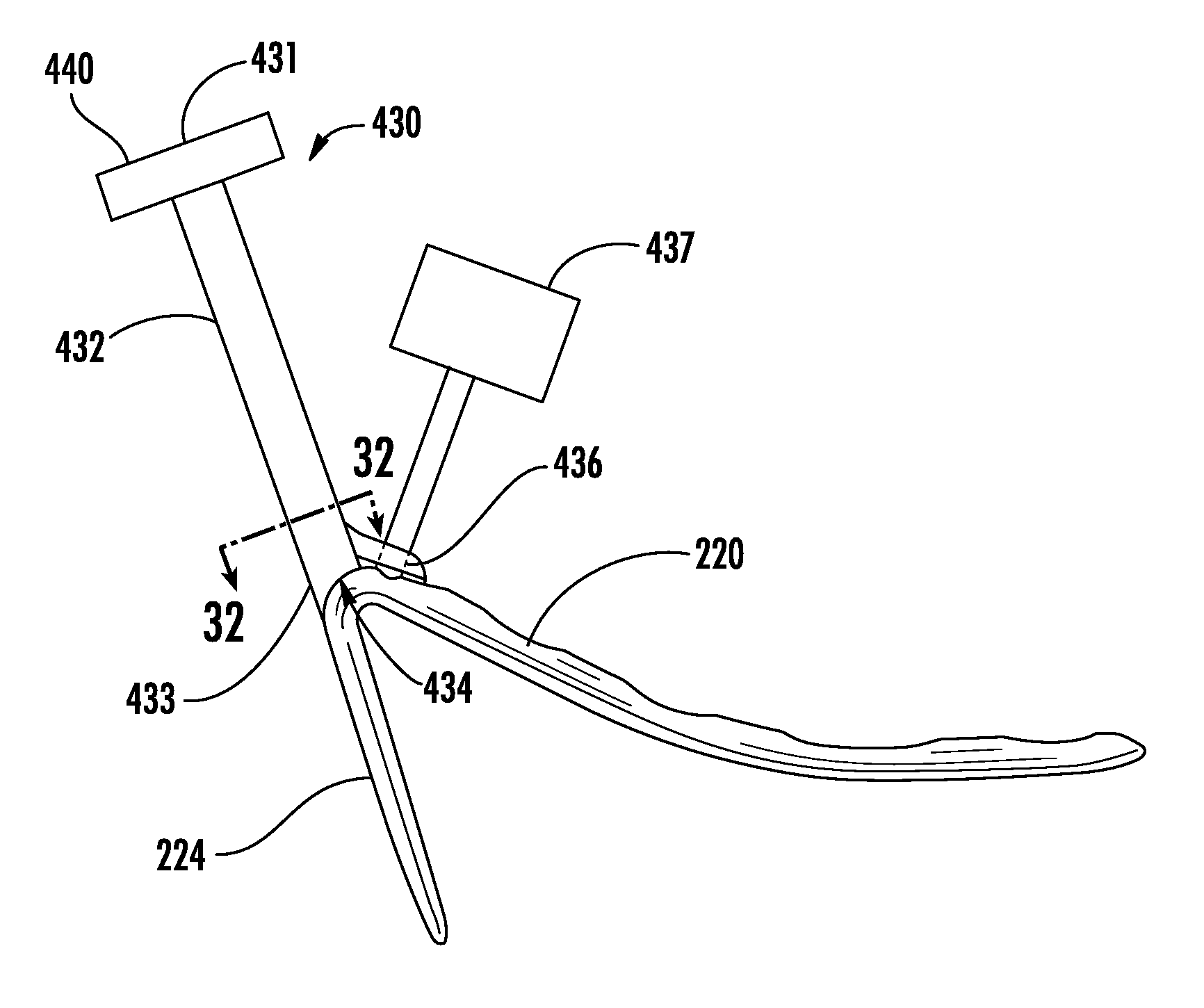Difficulties in using
bone plates may arise in certain fractures occurring relatively close to the end of a bone, creating a relatively small end fragment.
In this situation, there may simply be not enough bone available in the end fragment to accommodate a sufficient number of screws to achieve secure fixation.
As a result, a surgeon using a conventional
bone plate may use a suboptimal number of screws, which can lead to postoperative failure.
In such situations, only a very small distal fragment may be present, providing inadequate room for more than one or two screws to be placed.
Moreover, since the deep portion of this bone is a part of the overall
ankle joint, screws cannot be placed through both cortices, as is commonly practice with plate / screw techniques.
Accordingly, the surgeon may be faced with the undesirable situation of having the patient leave the operating room with only one or two screws engaging a
bone surface directly under a bone plate.
However, this terminal
bone fragment may still remain far from being well secured.
In addition, this technique does not address the problem of creating holes in the bone at the correct depth for engagement by the hooks, but rather relies on manual pressure on the plate to attempt penetration of the bone by the hooks at whatever level they happen to contact.
As can be noted by the examples in this article, the hooks may fail to penetrate the bone resulting in less than satisfactory engagement and fixation of the terminal fragment by the hooks as well as prominence of the hooks in the
soft tissue because of incomplete seating.
Finally, since these implants have hooks that extend an equal distance from the end of the plate, this design does not allow completely seating of both hooks in the common situation in which the
bone surface at the terminal end is at an angle to the plane that is perpendicular to the
long axis of the bone.
These fractures are often comminuted and unstable.
However, in the case of the distal
radius fractures, fixation that would produce this type of compressive loads between the articular fragments and the shaft may result in migration of the fragments, loss of length, malunions and failure.
First, since there are four posts integrally formed with the plate, a somewhat cumbersome
drill guide apparatus is required to be applied to the bone in order to
drill the holes for all four posts simultaneously.
This can be significantly difficult to achieve.
Since this plate was intended to be a single size approach to variable fracture patterns, fracture elements didn't always line up in the optimal position for
insertion of the tines.
In other words, this design lacks the flexibility often required to avoid placing tines directly through fracture lines (which can push fragments apart, contributing to
instability).
These issues can lead to inadequate fixation.
However, this design still remains a one size fits all solution, and lacks flexibility to line up fixation for some
complex fracture patterns.
Although this approach adds further flexibility to the direction of the fixation pegs, it still requires the surgeon to restore and hold the
anatomy while the fixation is taking place, which can sometimes be difficult to perform.
In addition, this design does not solve the problem of avoiding the placement of pegs through fracture lines, since the relative position of the peg holes is fixed, and moving the entry of one peg by shifting the plate to a different location results in corresponding movement of the placement locations of all of the other associated pegs.
Since it is known that thick implants close to the rim of the distal radius may often cause
irritation and even rupture of important tendons and other vital structures nearby, existing volar generally plates do not extend to the distal rim.
As a result, small fractures of the distal volar rim are often not be secured by these plate designs, which can result in the fragment flipping over the edge of the plate, potentially causing catastrophic loss of reduction and
dislocation of the
carpal bones of the
wrist.
These multiple steps can be somewhat difficult and
time consuming, and may be an objection to application of this technique.
However the surgical technique for this type of
implant does require pre-drilling the holes for
insertion of the legs of the
buttress pin.
These steps can be difficult to perform, often requiring surgeons with above average ability and experience.
In addition, since these types of implants are a type of bent wire, they lack the strength and rigidity of larger plates.
Although early designs such as the LCP
Hook Plate manufactured by Synthes, Inc.
wrap around the end of the bone, these types of implants do not achieve any internal purchase of the fragment to be secured, and may have very limited to no purchase overall, resulting in poor
rotational stability and limited resistance to sideways drift of the terminal fragment.
For fixation of the distal radius, however, the configuration of these types of hook plates is not optimal, especially for fractures involving the volar or dorsal rim.
 Login to View More
Login to View More  Login to View More
Login to View More 


